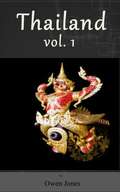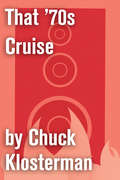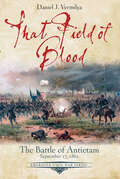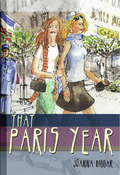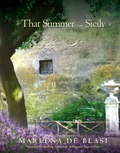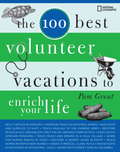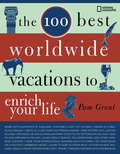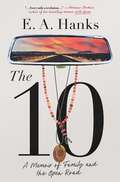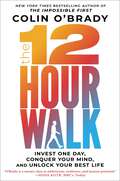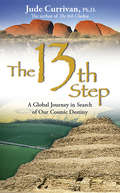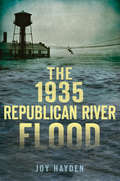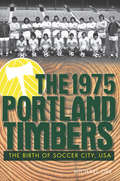- Table View
- List View
Thailand: Volume I (How to... #30)
by Owen JonesHallo und danke, dass Sie dieses E-Book mit dem Namen 'Thailand: Volume I’ gekauft haben. Ich hoffe, dass Sie den Inhalt hilfreich, nützlich und profitable finden. Die Informationen in diesem E-Book über verschiedene Aspekte Thailands und dem Leben in Thailand sind auf 15 Kapitel mit jeweils 500-600 Wörtern aufgeteilt. Ich hoffe, dass es diejenigen, die Thailand bereits besucht haben, jemanden kennen, der Thailand besucht hat oder diejenigen, die einen Besuch planen, interessiert. Als ein zusätzlicher Bonus gebe ich Ihnen die Erlaubnis, den Inhalt auf Ihrer eigenen Webseiten oder Ihren Blogs/Newslettern zu nutzen, obwohl ich es besser fände, wenn Sie erst alles mit Ihren eigenen Worten umschreiben würden. Sie können das Buch ebenfalls aufteilen und die Artikel weiterverkaufen. Das einzige Recht, welches Sie tatsächlich nicht haben, ist es, das Buch so wie Sie es erhalten haben, weiterzugeben. Wenn Sie Anmerkungen haben, lassen Sie sie bitte an der Stelle, wo Sie das Buch gekauft haben. Noch einmal Danke, dass Sie das Buch gekauft haben. MfG, Owen Jones
Thailandia: Volume 2 (Come fare... #96)
by Owen JonesThailandia Volume 2 Questo è il secondo volume che riguarda la mia personale esperienza della vita in Thailandia. Spero che troverete il contenuto utile e redditizio. Le informazioni contenute in questo ebook sui vari aspetti della Thailandia e la vita in Thailandia sono organizzate in 15 capitoli di circa 500-600 parole ciascuno. Spero che questo libro possa interessare sia a chi ha visitato la Thailandia, sia a chi intenda farlo. Come bonus aggiuntivo, vi concedo il permesso di utilizzare i contenuti sul vostro sito web o nei vostri blog e newsletter, anche se è meglio che prima li riscriviate con le vostre parole. Potete anche dividere il libro e rivendere gli articoli. Infatti, l'unico diritto che non avete è quello di rivendere o cedere il libro così come vi è stato consegnato.
Thailandia: Volume 3 (Thailand #17)
by Owen JonesThailandia Volume 3 Spero che troverete il contenuto utile e redditizio. Le informazioni contenute in questo ebook sui vari aspetti della Thailandia e della vita in Thailandia sono organizzate in 15 capitoli di circa 500-600 parole ciascuno. Spero che possa interessare sia chi ha visitato la Thailandia, oppure se conoscete qualcuno che l'ha fatto o che intenda farlo, perché gli articoli contengono le esperienze personali di 14 anni di permanenza dell'autore in Thailandia. Come bonus aggiuntivo, vi concedo il permesso di utilizzare i contenuti sul vostro sito web o nei vostri blog e newsletter, anche se è meglio se prima li riscriviate con parole vostre. Potete anche dividere il libro e rivendere gli articoli. In realtà, l'unico diritto che non avete è quello di rivendere o regalare il libro così come vi è stato consegnato.
Thailandia: Volume I (Come fare... #30)
by Owen JonesThailandia Volume One Le informazioni contenute in questo ebook sui vari aspetti della Thailandia e della vita in Thailandia sono organizzate in 15 capitoli di circa 500-600 parole ciascuno. Spero che possano interessare chi ha visitato la Thailandia, oppure se conoscete qualcuno che l'ha fatto o che intenda farlo, perché gli articoli contengono le esperienze personali di 14 anni di permanenza dell'autore in Thailandia. Come bonus aggiuntivo, vi concedo il permesso di utilizzare i contenuti sul vostro sito web o nei vostri blog e newsletter, anche se è meglio se prima li riscriviate con parole vostre. Potete anche dividere il libro e rivendere gli articoli. In realtà, l'unico diritto che non avete è quello di rivendere o regalare il libro così come vi è stato consegnato.
That '70s Cruise
by Chuck KlostermanOriginally collected in Chuck Klosterman IV and now available both as a stand-alone essay and in the ebook collection Chuck Klosterman on Rock, this essay is about a cruise.
That Field of Blood: The Battle of Antietam, September 17, 1862 (Emerging Civil War Series)
by Daniel VermilyaExplore the sites of the American Civil War’s Battle of Antietam and its history with this extensive guide.September 17, 1862—one of the most consequential days in the history of the United States—was a moment in time when the future of the country could have veered in two starkly different directions.Confederates under General Robert E. Lee had embarked upon an invasion of Maryland, threatening to achieve a victory on Union soil that could potentially end the Civil War in Southern Independence. Lee’s opponent, Major General George McClellan, led the Army of the Potomac to stop Lee’s campaign. In Washington D.C., President Lincoln eagerly awaited news from the field, knowing that the future of freedom for millions was at stake. Lincoln had resolved that, should Union forces win in Maryland, he would issue his Preliminary Emancipation Proclamation.All this hung in the balance on September 17: the day of the battle of Antietam.The fighting near Sharpsburg, Maryland, that day would change the course of American history, but in the process, it became the costliest day this nation has ever known, with more than 23,000 men falling as casualties.Join historian Daniel J. Vermilya to learn more about America’s bloodiest day, and how it changed the United States forever in That Field of Blood.“I highly recommend this book for anyone interested in the Battle of Antietam…. Vermilya is a fine author who has done a great service to this series.” —Gettysburg Chronicle“A meticulous and impressively informative read, That Field of Blood is a very highly recommended addition to personal, community, and academic library American Civil War History collections and supplemental studies lists.” —Midwest Book Review“A very good job presenting conclusions and providing a springboard for further discussion about the campaign and its historical consequences. That is what a good historian should do.” —Civil War News“Buy it, read it, think about it...then go to the battlefield. I've always stressed that standing in the very spot where significant historical events took place is essential when attempting to take in the full scale of the history. On the battlefield, That Field of Blood would make a great companion to the experience.” —The Rogue Historian
That Paris Year
by Joanna BiggarIn That Paris Year, five smart, adventurous young women arrive on the banks of the Seine in 1962 for their junior year abroad. What they get is an education of a different sort. As they move from the grueling demands of the Sorbonne by day to late nights of discovery in smoky cafes, the young Americans discover a mythical country shaped not only by the upheavals of history, but by the great French writers of the 20th Century, a place where seduction is intellectual as well as sexual. Ten years later, our narrator, J. J., is asked to speak at her old college on the virtues of going abroad. Drawing on the emotionally charged tools of memory and imagination, as well as old journals, letters, and telegrams, she chronicles and re-creates the story of that momentous year. Following in the footsteps of Marcel Proust, Joanna Biggar has written a novel in which intellect, eroticism, and art reverberate from the page to the heartbeat of the City of Light, an American book with the sweep and elegance of French literary tradition.
That Summer in Sicily
by Marlena De Blasi"At villa Donnafugata, long ago is never very far away," writes bestselling author Marlena de Blasi of the magnificent if somewhat ruined castle in the mountains of Sicily that she finds, accidentally, one summer while traveling with her husband, Fernando. There de Blasi is befriended by Tosca, the patroness of the villa, an elegant and beautiful woman-of-a-certain-age who recounts her lifelong love story with the last prince of Sicily descended from the French nobles of Anjou. Sicily is a land of contrasts: grandeur and poverty, beauty and sufferance, illusion and candor. In a luminous and tantalizing voice, "That Summer in Sicily" re-creates Tosca's life, from her impoverished childhood to her fairy-tale adoption and initiation into the glittering life of the prince's palace, to the dawning and recognition of mutual love. But when Prince Leo attempts to better the lives of his peasants, his defiance of the local Mafia's grim will to maintain the historical imbalance between the haves and the have-nots costs him dearly. The present-day narrative finds Tosca sharing her considerable inherited wealth with a harmonious society composed of many of the women-now widowed-who once worked the prince's land alongside their husbands. How the Sicilian widows go about their tasks, care for one another, and celebrate the rituals of a humble, well-lived life is the heart of this book. Showcasing the same writerly gifts that made bestsellers of" A Thousand Days in Venice" and "A Thousand Days in Tuscany," "That Summer in Sicily," and de Blasi's marvelous storytelling, remind us that in order to live a rich life, one must embrace both life's sorrow and its beauty. Here is an epic dramathat takes readers from Sicily's remote mountains to chaotic post-war Palermo, from the intricacies of forbidden love to the havoc wreaked by Sicily's eternally bewildering culture.
That's Not English
by Lynne Truss Erin MooreAn expat's witty and insightful exploration of English and American cultural differences through the lens of language that will leave readers gobsmackedIn That's Not English, the seemingly superficial differences between British and American English open the door to a deeper exploration of a historic and fascinating cultural divide. In each of the thirty chapters, Erin Moore explains a different word we use that says more about us than we think. For example, "Quite" exposes the tension between English reserve and American enthusiasm; in "Moreish," she addresses our snacking habits. In "Partner," she examines marriage equality; in "Pull," the theme is dating and sex; "Cheers" is about drinking; and "Knackered" covers how we raise our kids. The result is a cultural history in miniature and an expatriate's survival guide. American by birth, Moore is a former book editor who specialized in spotting British books--including Eats, Shoots & Leaves--for the US market. She's spent the last seven years living in England with her Anglo American husband and a small daughter with an English accent. That's Not English is the perfect companion for modern Anglophiles and the ten million British and American travelers who visit one another's countries each year.
That's Not English: Britishisms, Americanisms, and What Our English Says About Us
by Lynne Truss Erin MooreAn expat's witty and insightful exploration of English and American cultural differences through the lens of language that will leave readers gobsmackedIn That's Not English, the seemingly superficial differences between British and American English open the door to a deeper exploration of a historic and fascinating cultural divide. In each of the thirty chapters, Erin Moore explains a different word we use that says more about us than we think. For example, "Quite" exposes the tension between English reserve and American enthusiasm; in "Moreish," she addresses our snacking habits. In "Partner," she examines marriage equality; in "Pull," the theme is dating and sex; "Cheers" is about drinking; and "Knackered" covers how we raise our kids. The result is a cultural history in miniature and an expatriate's survival guide. American by birth, Moore is a former book editor who specialized in spotting British books--including Eats, Shoots & Leaves--for the US market. She's spent the last seven years living in England with her Anglo American husband and a small daughter with an English accent. That's Not English is the perfect companion for modern Anglophiles and the ten million British and American travelers who visit one another's countries each year.
That's So New York: Short (and Very Short) Stories about the Greatest City on Earth
by Dan SaltzsteinCharming, poignant, and occasionally salacious, That’s So New York is brimming with little snapshots of humanity that make one thing clear: There’s no place like New York.New York Times editor and lifelong New Yorker Dan Saltzstein compiles hundreds of distinctly New York moments for this peek at the city that never sleeps. Inspired by Saltzstein’s viral Twitter thread, this illustrated book features hilarious anecdotes from locals and transplants, short essays from folks like Molly Jong-Fast and Michael Ian Black, who have seen it all, and Q&As with everyday New Yorkers from across the five boroughs. Eels wriggling through subway cars, accidentally stumbling onto the set of Law & Order, drag queens emerging from manholes—if there’s one thing New York never runs out of, it’s stories. And rats. Always rats.INCREDIBLE TRUE TALES: These are real New York stories from real people who have lived or currently live in the city! While some are absolutely outlandish, the fact that these stories come from everyday people makes for an exciting reading experience for tourists and total relatability for locals. Topics range from the subway to celebrities, crime and grime to the New York slice, doorman dish to the (sometimes weird) rules of the city ("I'm walkin' here!"), and much more.EXPERT AUTHOR: As a lifelong New Yorker, senior editor for the New York Times, and creator of the popular Twitter thread that inspired this book, Dan Saltzstein has a wealth of knowledge about New York and an incredible network within it. This collection brings together the voices of notables like Alexander Chee, Molly Jong-Fast, Isaac Fitzgerald, and Megan Abbott with everyday folks like sanitation workers, doormen, train operators, and bartenders who make the city run.ULTIMATE NYC GIFT BOOK: In a highly giftable, affordably priced package, this is the perfect present for current New Yorkers, anyone who has ever lived in New York, and visitors who love the Big Apple!Perfect for:People from New York, past and presentTravelers and tourists planning or returning from a trip to NYCGift-diving to NY transplantsBirthday or holiday gift for family and friends who love city stories
Thaïlande: Volume 1 (Comment faire... #30)
by Owen JonesThaïlande Volume 1 Bonjour et merci d’avoir acheté cet eBook intitulé « Thaïlande : Volume I ». J’espère que son contenu vous sera d’une aide quelconque, et qu’il vous sera utile et profitable. Les informations de ce livre numérique sur les divers aspects de la Thaïlande, et la vie là-bas sont organisées en 15 chapitres d’environ 500 à 600 mots chacun. J’espère qu’il suscitera l’intérêt de ceux qui ont déjà visité la Thaïlande, ou qui connaissent quelqu’un qui l’a visitée, ou qui ont l’intention de le faire. En guise de supplément, je vous accorde la permission d’utiliser le contenu de l’ouvrage sur votre propre site internet, blog ou newsletter, même si je recommande au préalable la réécriture avec vos propres mots. Vous pouvez séparer le livre en plusieurs articles que vous pouvez revendre. En fin de compte, la seule chose qui ne vous est pas autorisée est la revente ou la cession de l’ouvrage sous la forme dans laquelle vous l’avez obtenu. Merci d’adresser, le cas échéant, vos commentaires à la société de laquelle vous avez acheté ce livre. Je vous remercie encore pour l’achat de cet eBook, Sincèrement, Owen Jones.
The 100 Best Affordable Vacations
by Jane Wooldridge Larry BleibergEven in a weakened economy, research shows interest in travel is still strong and this book provides 100 great ways to satisfy your wanderlust without breaking the bank. Like the other books in this popular series, The 100 Best Affordable Vacations to Enrich Your Life features out of the ordinary opportunities. They will just be less expensive, with some even free! Vacation categories include Classic Americana; Learning Vacations; Wilderness Trips; and Mind, Body, and Soul themed getaways. With this mix, there are lots of creative ideas and appealing destinations for everybody, whatever their interests, schedule, or budget. This book also offers profiles of inspirational travelers, as well as fun, lively sidebars about off-season travel, how to be a traveler and not a tourist, and more.
The 100 Best Affordable Vacations
by Jane WooldridgeThis guide features out of the ordinary opportunities. They will just be less expensive, with some even free! Vacation categories include Classic Americana; Learning Vacations; Wilderness Trips; and Mind, Body, and Soul themed getaways.
The 100 Best Vacations to Enrich Your Life
by Pam GroutTravel statistics say that baby boomers travel more than any other age group in America—and that an ever increasing number of them are looking for ways to spend their leisure time in substantial, meaningful ways. One especially fast-growing area of interest is the "experience-driven" or "wellness" vacation, a proactive approach based on the idea that true recreation involves positive engagement: acquiring a new skill or volunteering to share your own expertise; exercising your intellect or extending yourself in some creative, physical, or spiritual way. In response to such aspirations, this timely book showcases a broad range of the most life-enriching getaways in the U. S. , Canada, and Mexico, with something for every taste and every interest. Here are programs dedicated to kayaking lessons, mountain biking, yoga instruction, and more. Perhaps you'd prefer to spend an arts and crafts holiday focused on a creative activity like cooking, painting, or woodworking. Imagine studying French in a Maine village, learning about nutrition at a historic North Carolina spa, or helping rebuild the devastated communities of the Gulf Coast. Weave a Navajo rug; make a film in New York; learn to surf in Mexico; or choose any of scores of other possibilities. Elegantly designed and packed with attractive and fun descriptions, detailed travel information, lists of unique activities, and special sidebars, this unusual resource tells you all you need to know to ensure that your next vacation won't just be time off—it will be time well spent.
The 100 Best Vacations to Enrich Your Life
by Pam GroutImagine studying French in a Maine village, learning about nutrition at a historic North Carolina spa, or helping rebuild the devastated communities of the Gulf Coast. Weave a Navajo rug; make a film in New York; learn to surf in Mexico; or choose any of scores of other possibilities.
The 100 Best Volunteer Vacations to Enrich Your Life
by Pam GroutTravel industry experts report that more and more people are combining vacations with volunteer work—the growing phenomenon called "voluntourism." Professionals predict this will be a key growth area for years to come; the voluntourists themselves find it a rewarding activity, good for body and soul. And nobody provides such a fun, inviting overview of the possibilities as savvy travel writer Pam Grout in the latest title in our 100 Best Vacations series. With its elegant two-color design, playful cover, and winningly positive goal, it’s a travel guide with heart, inexpensive yet inspiring—an ideal gift book for people who care to share. From building houses in Appalachia to saving sea turtles in Costa Rica to teaching English in Thailand, this book is a rich resource of ways to use your skills to help out the world and reap some lasting benefits yourself. Like its two predecessors, it includes an engagingly descriptive menu of choices for tastes and talents of all kinds, along with detailed specifics to turn good intentions into satisfying reality. Throughout, sidebars describe nearby places to visit, little-known facts, and more, providing depth and variety, while a comprehensive resource listing gives additional information about the different organizations offering volunteer vacations.
The 100 Best Volunteer Vacations to Enrich Your Life
by Pam GroutFrom building houses in Appalachia to saving sea turtles in Costa Rica to teaching English in Thailand, this book is a rich resource of ways to use your skills to help out the world and reap some lasting benefits yourself.
The 100 Best Worldwide Vacations to Enrich Your Life
by Pam GroutThe author of the North American destination-centered 100 Best Vacations to Enrich Your Life (2007) aims to shake up travelers' preconceptions about other countries and themselves, by detailing the why's and how's of such vacations as learning to belly dance in Turkey, test-driving a fantasy career as a chef in culinary hotspots, or assembling wheelchairs for land mine victims in Cambodia. Chapters on arts & crafts getaways, volunteer vacations, learning retreats, and wellness escapes include a resource or two. Annotation ©2008 Book News, Inc. , Portland, OR (booknews. com)
The 10: A Memoir of Family and the Open Road
by E.A. HanksFrom Vanity Fair and The New York Times contributor comes a beautifully written, deeply felt memoir recounting the solo, cross-country journey she made along the Ten across the American southwest: a mission to uncover both what harrowing violence may or may not have happened to her late mother, but also, to look within and discover who she herself is—where her mother ends and she begins.In her trusted loaded-up minivan &“Minnie,&” E.A. Hanks follows the same route as a long-ago road trip with her mother in an attempt to better understand the complicated woman who gave her life. Along the way, as she follows her mother&’s diaries and her own recollections of the route, she begins to uncover secrets—some unexpectedly wonderful, and others darker and more violent than she ever imagined—that bring more questions than answers. From the quiet expanses of White Sands National Park to the bustling streets of New Orleans, and the Texas-Mexico border to the swamps of the Florida panhandle, she interacts with the amazing breadth and diversity of the people that call these places home. Reckoning with the past, the present, her memories, and herself, Hanks brings us along a beautiful voyage towards understanding how the stories we tell about the places we&’re from ultimately become the stories we tell about the people we are.
The 12-Hour Walk: Invest One Day, Conquer Your Mind, and Unlock Your Best Life
by Colin O'BradyFrom the New York Times bestselling author of The Impossible First, a compelling blend of riveting adventure stories and hard-won wisdom that teaches us how to overcome our limiting beliefs and embark on a transformative one-day journey that will unlock our best lives. Millions of people dream of living a more fulfilling life, yet many settle for a life of comfortable complacency, allowing excuses and negative thoughts to invade their minds. I don&’t have enough time…I don&’t have enough money…I&’m afraid to fail...I don&’t have what it takes—we allow these limiting beliefs to control us. Now comes The 12-Hour Walk, which provides the inspiration—and catalyst—for getting unstuck and realizing your full potential. Featuring life lessons from explorer, endurance athlete, and entrepreneur Colin O&’Brady—whose adventures in such extreme places as Antarctica and the perilous Drake Passage and on the peaks of Mount Everest and K2 have seen him establish ten world records—this book&’s vivid narrative and powerful insight will show you how you can embark on your own life-changing journey. With Colin as your guide, The 12-Hour Walk asks you to invest one day in yourself. The goal? Conquering your mind and becoming your best self. By walking alone, unplugging, listening to the voice within, and rewriting the limiting beliefs etched into your psyche, you can break free of the patterns holding you back and learn how to cultivate a &“Possible Mindset&”—an empowered way of thinking that unlocks a life of limitless possibilities. The reward: being the hero of your own destiny.
The 13th Step: A Global Journey In Search Of Our Cosmic Destiny
by Jude CurrivanIn 1998, scientist, healer, and mystic Jude Currivan heard an inner message-a call to undertake a global quest that would transform her life and take her and her fellow travelers on an inner and outer odyssey that would ultimately reveal our hidden heritage and cosmic destiny. The initial intention of these journeys was to activate the healing energies of 12 ancient Lemurian artifacts around the earth to support the collective shift of awareness prophesied for 2012. But an even deeper purpose began to unfold. . . The native elders of indigenous traditions around the world say that in these momentous times, "We are the ones we have been waiting for." As did the heroes of mythology, we are now about to embark on a spiritual quest to remember the wholeness of who we really are. The 12 activations and the opening of a galactic portal were completed during the December solstice of 2003, but in 2006 a further call heralded a 13th healing journey. As we approach 2012 and experience the birth pangs of a new age, this book shares an inspirational message of hope and reconciliation. It offers an empowering call for every one of us to embody our own divinity and fulfill our highest purpose as the heroes of this transformation.
The 1935 Republican River Flood (Disaster)
by Joy HaydenOn May 31, 1935, a storm system surged along the Republican River, bursting its banks in a matter of minutes with a roar that could be heard miles away. The greatest flood to hit the tri-state area of Colorado, Kansas and Nebraska, it left behind a landscape rearranged beyond recognition and claimed more than one hundred casualties. However, amid all the destruction and sorrow, amazing acts of heroism and unwavering courage were reported throughout the valley. Author Joy Hayden reveals the historic disaster and the steadfast resolve of those who witnessed it.
The 1975 Portland Timbers: The Birth of Soccer City, USA (Sports)
by Michael OrrRelive the magic of the Portland Timbers' 1975 season and the birth of Soccer City, USA. This is the story of seventeen players and two coaches who came from different clubs and different countries to form a team just days before their inaugural game. In this fast-paced account, Michael Orr weaves together player interviews, news coverage, and game statistics to capture the Timbers' single-season journey from expansion team to championship contender. From the first televised game against Pele's New York Cosmos to the seven-game winning streak that vied for a league record and the post-season battle for the game's highest prize, rediscover how, in just four months, the Timbers won the hearts of Portlanders and left an indelible stamp on the Rose City's sporting landscape.
The 2024 New Jersey Driver Manual English
by State of New JerseyThe New Jersey Driver Manual will help you learn and understand safe driving practices. This manual provides valuable information that you will need to pass the knowledge portion of New Jersey’s driver test. The manual will offer important safety information to help you become a safe, courteous, and aware driver. If you already have a New Jersey driver license, this manual can help you refresh your knowledge and provide an update for new laws and rules of the road. Please remember: Driving Is A Privilege, Not A Right. The information contained in this manual should be used as a general guide to the rules of driving a motor vehicle but not as a substitute for the actual laws. If there is a discrepancy between what is cited in this manual and what is in statute or regulation, the statute or regulation governs. This manual is not a legal reference for New Jersey motor vehicle and traffic laws.
